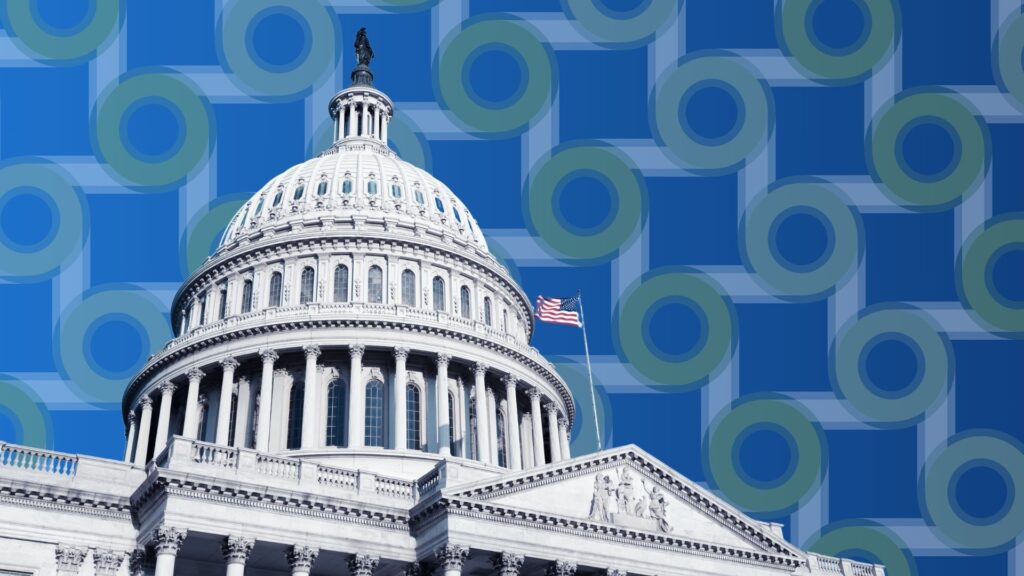- News
Tracking Tax Reform in 2025
Congress is focused on addressing the pending expirations of the Tax Cuts and Jobs Act (TCJA) prior to the end of this calendar year. Here’s where things stand and what market participants should know.

NOTE:
The following article will continue to evolve as updates emerge. We will attempt to annotate when major changes and clarifications occur. It is intended to provide updates on current events and is not intended to provide legal or financial advice or counsel as to any particular situation. The National Association of Bond Lawyers (NABL) takes no responsibility for the completeness or accuracy of this material. You are encouraged to conduct independent research of original sources of authority. If you discover any errors or omissions, please direct those and any other comments to NABL.
In December 2017, Congress passed the Tax Cuts and Jobs Act (TCJA)—a sweeping reform of the U.S. tax code that included a number of permanent changes as well as other provisions set to expire at the end of Calendar Year 2025. The process leading up to the passage of TCJA included various threats to the tax-exempt municipal market. A version of the bill that passed the House of Representatives even included a widespread repeal of the tax exemption for qualified private activity bonds (PABs). The final enacted bill repealed the tax exemption for advanced refunding bonds.
Regardless of the outcome of the 2024 elections, municipal market participants have recognized the high potential for legislative action on tax reform in 2025 and—more specifically—the potential for threats to the tax exemption on municipal bonds to reemerge. NABL and other municipal market groups have launched an array of advocacy resources to enable and encourage market participants to advocate early and often for tax-exempt municipal bonds.
As the process to address looming TCJA expirations unfolds this year, developments will likely come piecemeal and through both formal and informal channels. In order to help NABL members stay on top of these developments we have created and will maintain this tracker to organize important updates chronologically. NABL members will receive urgent updates via “NABL Alert” emails.

How Can I Support Bonds?
Our grassroots advocacy center has everything you need to be an advocate for community finance and tax-exempt municipal bonds.
Timeline of Updates
[New Updates]
March
Weekly Update: March 28, 2025
Congressional leaders in both chambers have largely coalesced around idea of tackling all of the President’s financial agenda in “one, big beautiful” bill. The House and Senate have passed competing budget resolutions, and differences between the two must be ironed out in a concurrent resolution to begin the process of crafting a forthcoming reconciliation bill. Senate leadership is hopeful, however, that they can pass a budget resolution that aims to tackle the same breadth of agenda items as those listed in the House resolution—including expirations of select TCJA provisions and addressing the federal government’s debt limit. Senate Budget leadership aims to craft and pass a budget resolution that concurs with the broad goals of the House’s resolution, but provides differing instructions to Senate Committees than those provided to House Committee’s. Such a move would allow both chambers to proceed with reconciliation work, while punting more specific policy disagreements to be ironed out at a later stage.
At this point in time, the Senate aims to pass a new budget resolution prior to adjourning for its Easter recess on April 11. Meanwhile, the House Ways and Means Committee continues to meet and discuss initial policy plans for a forthcoming reconciliation package.
Revised estimated timelines for the federal government’s x-date now suggest that Congress has until late summer or early fall to address the debt ceiling. These estimates will be further updated once the federal government passes the April 15 deadline for income tax filings. Later estimated dates suggest Congress has more time to include further financial policy goals, such as extending TCJA provisions, in a legislative vehicle to address the debt ceiling.
- [3/26/2025] CBO: X-Date Likely in August/September: The Congressional Budget Office (CBO) released its estimate that “if the debt limit remains unchanged, the government’s ability to borrow using established ‘extraordinary measures’ will probably be exhausted in August or September 2025.” Read CBO Report >
February
Weekly Update: February 28, 2025
Late in the evening on February 25, the House of Representatives passed its version of a budget resolution. This version of the budget resolution differs from a resolution that passed the Senate last week. Tuesday’s vote represents a significant advance in the Republican effort to address the expirations of the TCJA in the first half of this year, but a number of challenges remain. While this plan is ambitious, municipal market participants should prepare for developments to occur along this timeline. Read Full Update on House Resolution >
- [2/25/2025] House Passes Budget Resolution: Late in the evening on Tuesday, February 25, the House of Representatives passed its version of a budget resolution. This version of the budget resolution differs from a resolution that passed the Senate last week.
- What is in the Resolution: The House resolution establishes a federal budget for FY2025, sets budgetary levels for the federal government for FY2026-2034, and provides instructions to specific Committees to begin working on a forthcoming budget reconciliation package that would reconcile federal revenues and expenditures to reach these budgetary levels. Those instructions direct the Ways and Means Committee to increase the federal expenditures over such time by no more than $4.5 trillion. This deficit threshold is to be reduced proportionally in the event that Committees, including the Committee on Ways and Means, fail to enact offsets that reduce that deficit by at least $2 trillion.
- What It Means in General: House Republicans plan to use this budget resolution to begin a budget reconciliation process that seeks to increase federal expenditures, which would include outlays and tax expenditures, by $4.5 trillion and reduce federal spending or increase revenues by $2 trillion. This subsequent reconciliation bill would aim to address the majority of the Republican party’s economic agenda—including extension and modification of select expiring provisions of the TCJA, other tax priorities, increased spending on national and border security, and addressing the pending U.S. federal government debt ceiling.
- Next Steps: Both the House and Senate must pass identical budget resolutions for both chambers to commence work on a reconciliation package. It seems likely that the Senate will now shift toward the House’s strategy to advance their economic agenda via one large bill instead of two separate ones. Members of Congress, however, will likely need to iron out remaining substantive differences across the chambers via either a formal conference committee or an informal pre-conference process. Once both chambers agree to a budget resolution, we will likely see the House take a lead start in suggesting and vetting specific policy proposals consistent with and seeking to accomplish the goals set forth in the budget resolution. The process of reconciliation is rather rigid and involves a number of steps.
- What It Means for the Municipal Market: At this time, Republicans are still aiming to use this budget reconciliation process to address the debt ceiling. In theory, the process would need to conclude before the approach of the debt ceiling x-date, which is likely some time in or around May. This week’s vote represents a significant advance in the Republican effort to address the expirations of the TCJA in the first half of this year. While this plan is ambitious, municipal market participants should prepare for developments to occur along this timeline. Despite inclusion on the House Budget Committee’s “Menu of Options,” the tax exemption continues to enjoy broad bipartisan support, and we have heard minimal threats to the tax-exempt status of municipal bonds from congressional offices. It is worth noting, however, that details surrounding offsets and revenue raisers will likely only manifest after both chambers pass identical budget resolutions and the elimination or reduction of the tax exemption for municipal bonds remains a potential option for negotiators. Municipal market participants should continue to advocate on behalf of the tax exemption.
WeeklY Update: February 21, 2025
While the House remained in recess this week, Republican leadership and negotiators were busy calling members to whip votes in favor of the House budget resolution in advance of potential floor action when members of Congress return to Washington, D.C. next week. The House package aims to advance much of the President’s economic agenda, including addressing expiration of certain TCJA provisions, via one bill. It faces potential headwinds, however, from moderate Republicans who fear the measure may pave the path for too drastic of cuts to federal spending. Despite apparent dismay from the President earlier this week, the Senate held a floor vote on Thursday to advance its more limited measure that would save work on TCJA for a second bill later in the year. Both chambers must agree upon the same budget resolution to set high level spending parameters prior to beginning work on specific policy measures in a forthcoming reconciliation package.
- [2/20/2025] Senate Advances Budget Resolution: The full Senate voted 52 to 48 to advance the chamber’s version of a budget resolution.
- [2/19/2025] Trump Backs House Approach: After previously maintaining no affirmative preference on whether his economic agenda was advanced via one or two reconciliation packages, President Trump threw his support behind the House budget resolution in a Truth Social post. The move surprised Senate leadership who spent the week working to advance their own budget resolution that would lay the groundwork for a two bill approach. Vice President JD Vance later told negotiators that while the President preferred a single bill approach, the White House understood the need for a backup approach to advance as well.
Weekly Update: February 14, 2025
The House and Senate have released and advanced competing budget resolutions out of Committees. While both versions would officially kick start the budget reconciliation process, the two chambers have varying approaches on how to enact President Trump’s economic agenda. The House is pursuing “one big, beautiful bill” that would attempt to tackle everything, including expiring provisions of the TCJA, in one sweep. Meanwhile, the Senate is advancing a narrower approach that aims to tackle energy, defense, and the border today, while saving TCJA for a later bill. Both packages propose cuts to federal spending, but the House’s proposal seeks to reduced federal costs by $1.5 to $2 trillion, which would put significant pressure on negotiators to find offsets.
- [2/13/2025] House Advances Budget Resolution: The House Budget Committee voted to advance its version of a budget resolution along party lines. Leaders of the House Freedom Caucus endorsed the package after striking an agreement that would effective limit the amount of tax cuts allowed in a forthcoming package if negotiators are unable to reach $2 trillion in spending cuts.
- [2/12/2025] House Unveils Competing Budget Resolution: In response to the Senate’s shift toward working on its own budget resolution, House leadership released their own version that seeks to tee up one forthcoming large reconciliation package. Unlike the proposal in the Senate, the House package would seek to tackle most of President Trump’s economic agenda, including expirations of the TCJA, in one singular reconciliation package. It would:
- Raise the debt ceiling by $4 trillion, which would effectively punt the next debt ceiling by an estimated two years
- Provide for $4.5 trillion worth of tax cuts and additional spending;
- Provide for $300 billion of new defense and border security spending;
- And, instruct negotiators to cut at least $1.5 trillion in other expenses.
- [2/12/2025] Senate Budget Committee Advances Resolution: After holding a markup of the budget blueprint released the week prior, the Senate Committee on Budget voted along party lines to advance the measure on to a floor vote.
- [2/7/2025] Senate Releases Budget Resolution: Coming out of a convening in Mar A Lago, the Senate Budget Committee Chairman, Lindsey Graham (R-SC), released his chamber’s budget resolution framework. Graham announced that the Senate Budget Committee would debate the blueprint next Wednesday and Thursday with a possible vote on the measure in the second half of next week. The Senate’s move comes as the House continues to work toward finding consensus on their chamber’s blueprint. The Senate’s blueprint is more limited in scope than what the House is expected to produce. It would authorize $85.5 billion in new annual spending to support investments in border security, national security, and domestic energy production.
- [2/6/2025] Trump Outlines Tax Reform Priorities: During a meeting with Senators at Mar A Lago, President Trump outlined his priorities for a forthcoming tax package. Information provided to the media about the meeting specifically referenced the President’s desire to “eliminate all the special tax breaks for billionaire sports teams owners.” Read More from Politico >
- [2/6/2025] Key Senators Want to Advance Their Own Budget Resolution: Senate Budget Committee Chairman Lindsey Graham (R-SC) announced this week that his chamber will attempt to advance its own version of a budget resolution, teeing up a process for the Senate to move before the House on a budget reconciliation package. Unlike the House, the Senate has favored advancing their priorities via two bills: a preliminary package to address immigration and energy, and a second one to address expirations of the TCJA later in the year.
- [2/4/2025] Higher Ed “Menu” Options: A new document was released, entitled “Possible Reconciliation Revenue Options Affecting Higher Education.” The document appears to be a reiteration of the earlier “Menu” of options with only specific line items related to higher education in America. It lists “Eliminate Exclusion of Interest on State and Local Bonds,” but does not include the bullet discussing the tax exemption on all other bonds, which would presumably include qualified 501(c)(3) bonds.
January
- [1/31/2025] PFN Letter to Congress: The Public Finance Network (PFN), including NABL, submits a letter to members of the 119th Congress in support of the tax exemption on municipal bonds. Read Letter >
- [1/17/2025] House “Menu” of Options: POLITICO published a document released from the House Budget Committee that appears to list 50 pages of potential revenue raisers that could pay for at least part of a large reconciliation bill later this year. The list appears to be a basis for discussion rather than concrete proposals that have achieved broad consensus from committee members. It is a large list of potential revenue raising options, extending far beyond the realm of tax. Although many of the options are likely unviable and specifics remain ambiguous, the document does represent the first written document from this Congress suggesting to alter the tax-exempt status of interest on municipal bonds. It also further validates the early advocacy work by municipal market groups such as NABL and illuminates the need for market participants to advocate early and often for tax-exempt municipal bonds. Some of the listed options include changing existing law to:
- Eliminate exclusion of interest on state and local bonds;
- End tax preferences for “other bonds” (with a note indicating that this means “private activity bonds and Build America Bonds”);
- Eliminate “nonprofit status” for hospitals;
- Expand taxes on large college endowments;
- Advance other proposals relating to entitlement reforms, the state and local tax (SALT) deduction, and other development tax incentives.
The Essentials: May 14-16, 2025
A foundational conference designed for attorneys and other municipal market participants new to areas of bond law. Join us in Kansas City, MO and walk away with a deeper understanding of the rules and laws governing the $4 trillion municipal market.
